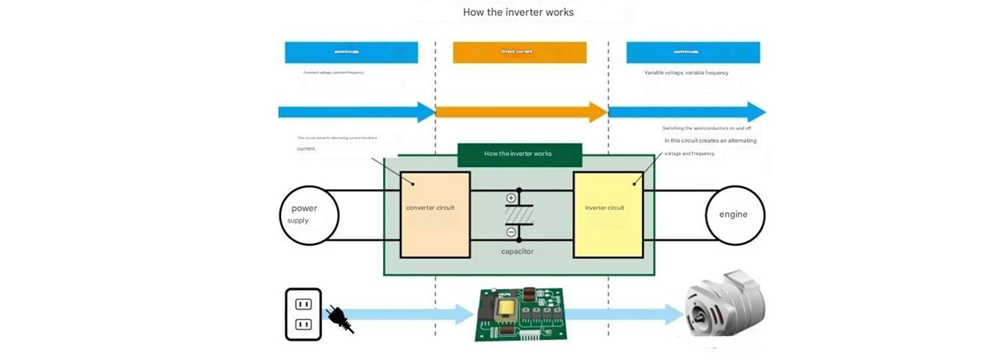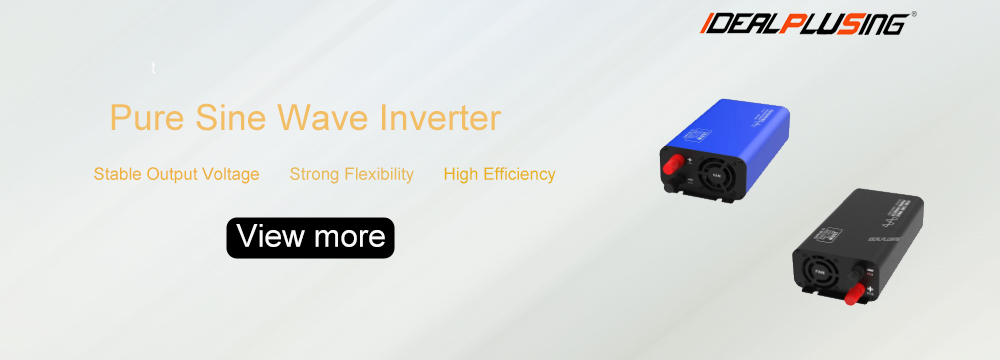Inverter, in essence, refers to a circuit or device containing such a circuit that converts current from direct current to alternating current.
Have you ever heard another word often in air conditioner and washing machine advertisements - frequency converter? In fact, it is also "Inverter", which can refer to the power inverter device used for household appliances. Household appliances, elevators and conveyor belts do not accelerate or stop suddenly, also because the acceleration of the motor can be well regulated by the inverter device. What kind of technology is frequency converter? Let's take air conditioners as an example. Air conditioners without frequency converters will stop working when the weather is too cold and will only resume operation when the weather gets hot, which is very inefficient because the indoor temperature is unstable and the power consumption is high.
But air conditioners equipped with frequency converters are different. When cooling starts, the motor rotates at high speed to rotate the fan, and when the temperature approaches the set value, the fan slows down and continues to run in a gradual manner. This reduces energy waste and is more energy-efficient. It can flexibly change the rotation speed and acceleration of the motor to adapt to the required application, so the term "frequency converter" is often used in the field of household appliances. For example, more and more induction cookers are operated with extremely high frequency AC power of 20 kHz to 90 kHz, which is achieved by changing the frequency using an inverter. How does an inverter change the frequency?
An inverter consists of three components: a converter circuit that converts AC current to DC current, a capacitor, and a power inverter circuit.
First, the converter circuit converts AC power to DC power, and then repeatedly charges and discharges the capacitor to produce stable DC power. Next, the inverter circuit converts DC power to AC power output of the required frequency and voltage.

Principle of power inverter circuit

We explain the working principle of the power inverter circuit based on the circuit diagram with four switches shown in the figure above, which converts DC power to AC power. When a DC power source is connected to the circuit and switches (1) and (4) are open, switches (2) and (3) are closed. When switches (1) and (4) are disconnected, switches (2) and (3) are connected, and the process is repeated in pairs at a fixed cycle. The direction of the current flowing to the load is switched, and the output is positive and negative, generating an AC current. This is called switching technology. Circuits using switching technology can also convert AC power into DC power. If switches (1) and (4) are closed when the voltage is in the positive direction, and switches (2) and (3) are closed when the voltage is in the negative direction, the current will always flow in the same direction as the load.
1. Working principle of inverter
1.1 Inverter is a DC to AC transformer, which is actually a voltage inversion process with converter. The converter converts the AC voltage of the power grid into a stable 12V DC output, while the inverter converts the 12V DC voltage output by the adapter into high-frequency high-voltage AC power; both parts use the commonly used pulse width modulation (PWM) technology. The core part is a PWM integrated controller, the adapter uses UC3842, and the inverter uses TL5001 chip. The operating voltage range of TL5001 is 3.6~40V. It has an error amplifier, a regulator, an oscillator, a PWM generator with dead zone control, a low voltage protection circuit and a short circuit protection circuit.
1.2 Input interface part: The input part has 3 signals, 12V DC input VIN, working enable voltage ENB and Panel current control signal DIM. VIN is provided by the Adapter, and the ENB voltage is provided by the MCU on the motherboard. Its value is 0 or 3V. When ENB=0, the inverter does not work, and when ENB=3V, the inverter is in normal working state; and the DIM voltage is provided by the motherboard, and its variation range is between 0~5V. Different DIM values are fed back to the feedback end of the PWM controller, and the current provided by the inverter to the load will also be different. The smaller the DIM value, the greater the current output by the inverter.
1.3 Voltage start loop: When ENB is high, the high voltage is output to light up the backlight tube of the Panel.
1.4 PWM controller: It has the following functions: internal reference voltage, error amplifier, oscillator and PWM, overvoltage protection, undervoltage protection, short circuit protection, output transistor
1.5 DC conversion: The voltage conversion circuit is composed of MOS switch tube and energy storage inductor. The input pulse is amplified by the push-pull amplifier and drives the MOS tube to switch, so that the DC voltage charges and discharges the inductor, so that the other end of the inductor can get AC voltage.
1.6 LC oscillation and output circuit: Ensure the 1600V voltage required for the lamp to start, and reduce the voltage to 800V after the lamp starts.
1.7 Output voltage feedback: When the load is working, the sampling voltage is fed back to stabilize the voltage output of the I inverter.
2. The relationship between pure sine wave inverter and inverter
The main difference between pure sine wave inverter and ordinary inverter is the quality of output waveform and application range.
2.1 Output waveform quality
Pure sine wave inverter: Outputs true sine wave AC with high waveform quality, suitable for various loads, including sensitive electronic equipment. Its output current is stable and will not cause noise or flickering problems to electrical equipment. Ordinary inverter: The output waveform is approximately sine wave, which may contain square wave and clutter components. It is suitable for general electrical equipment, but may interfere with or damage sensitive electronic equipment.
2.2 Scope of application
Pure sine wave inverter: Suitable for various electrical equipment, including lamps, televisions, refrigerators, computers, etc. Due to its high-quality output waveform, it is suitable for powering a variety of electrical equipment, especially equipment that requires high-quality power supply. Ordinary inverter: Suitable for simple electrical equipment, such as lamps and electric fans. Due to its low output waveform quality, it is not suitable for powering precision electronic equipment.
2.3 Technical requirements and cost
Pure sine wave inverter: High technical requirements, complex manufacturing process, and high cost. Suitable for electronic circuits with high requirements for waveform parameters.
Ordinary inverter: low technical requirements, simple manufacturing process, low cost. Suitable for general electrical equipment.
Pure sine wave inverter is an important component of outdoor power supply. It can convert battery DC into stable AC output, so that users can provide power support for various household appliances, digital devices, etc. through outdoor power supply.
3. What is the role of pure sine wave inverter? What are its advantages?
First of all, the main function of pure sine wave inverter is to provide high-quality AC output. In different outdoor activities, we need to provide power to different types of equipment, such as smartphones, tablets, cameras, audio equipment, etc., and the working principles and usage requirements of these devices are not the same. If an unstable power supply is used, it will not only damage the equipment, but also waste electricity. Therefore, the use of pure sine wave inverter can ensure the stability of output voltage and frequency, and will not cause any damage to the equipment.
Secondly, pure sine wave inverter is also characterized by high efficiency and energy saving. Compared with other inverters, pure sine wave inverters have higher conversion efficiency and more stable output current, so they can reduce power waste and extend battery life.
In addition, pure sine wave inverters can also reduce noise and electromagnetic interference. Using pure sine wave inverters can avoid the generation of clutter and noise, thereby ensuring the normal operation of the equipment.
Pure sine wave inverters are an important part of outdoor power supplies. They can provide high-quality, efficient, and stable AC output to meet the various power needs of users. For outdoor activities, camping, outdoor shooting and other occasions, choosing an outdoor power supply with stable performance and high efficiency will bring more convenience and comfort to your journey and life.
Share our interesting knowledge and stories on social media














